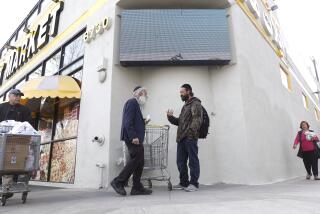Latinos Find a Hidden Jewish Heritage : Culture: Some Sephardic refugees from the Inquisition came to the New World and lived as Catholics. Traditions observed in secret for generations are now coming to light.
ALBUQUERQUE â Carlos Velez-Ibanez, a former Roman Catholic altar boy and graduate of parochial school, was astounded that day 30 years ago when his only sister died and his mother leaned over to whisper in his ear:
âIâm going to tell you a secret that has always been passed on through the women of our family. But now I must tell you.
âSomos Judios,â she said. Weâre Jews.
Initially stunned by the disclosure, the 54-year-old University of Arizona anthropologist says he now views his hidden ancestry as a family treasure.
For engineering student Daniel Yocum, the revelation came as he merged odd family customs with genealogical study and found a Jewish heritage: kosher food preparation, Friday night prayer, ritual circumcision and keeping the Sabbath.
âWe went to Catholic Mass on Saturdays,â says Yocum, 23, who grew up in Albuquerqueâs largely Latino South Valley. But, he says, âIf kids tried to do things on the (Jewish) Sabbath, they would get hit.â
Across the American Southwest, Latino descendants of Jews who fled the Spanish Inquisition are recovering remnants of their heritage 500 years after King Ferdinand and Queen Isabella of Spain issued the 1492 Edict of Expulsion. Under the edict, Jews and other non-Roman Catholics who would not convert to Christianity were ordered exiled or burned at the stake.
About half of the 200,000 Spanish Jews, called Sephardim after the Hebrew word for Spain, left the empire seeking more tolerant surroundings in North Africa, the Middle East and elsewhere in Europe. Those who remained became âNew Christians,â or fell victim to the Grand Inquisitor.
But recent research shows that a significant number of Jews who left Spain in the 15th and 16th centuries made their way to the New World.
Later, pursued in Mexico by officials of the Inquisition when they prospered as New Christians or tried to live openly as Jews, they again sought refuge--this time alongside Spanish conquistadors exploring the farthest reaches of New Spain, now the American Southwest.
There, historians now say, they survived on the remote frontier, living openly as Roman Catholics while covertly maintaining Jewish traditions and beliefs.
In the last few years, dozens of gravestones have been found in old Christian cemeteries engraved with both crosses and Hebrew inscriptions, some bearing the Star of David.
Scholars and descendants of these conversos or âcrypto-Jewsâ now are painstakingly trying to piece together this complex cultural mystery buried beneath 17 generations of secrecy.
In January, the first major international conference on the subject was held at the University of Arizona in Tucson.
Velez-Ibanez, whose family comes from a region that encompasses southern Arizona and northern Mexico, says he now understands why family members lighted candles on Friday nights, as is done on the Jewish Sabbath, and why they expressed a âstrict aversion to pork.â
Yocum says he now knows why his grandmother became irate when her husband, a carver, fashioned what Yocum now realizes was a menorah, or traditional candelabrum.
âMy grandma used to call him a âJudio,â â or Jew, Yocum says, âand say âleave the ways of the old men alone.â When he made the menorah, she got really mad and made him keep it in the garage.â
Third-grade teacher Anna Rael Delay, 44, of Lewisville, Tex., is converting to Judaism after a lifetime of questioning her roots. She is raising her 11-year-old son to go to temple.
âWhen I was young my grandmother used to light candles on Fridays and we took it for granted,â says Delay, who grew up in Santa Fe, N.M., and attended Catholic school.
She says that in tracing her family to 1610 in New Mexico, she has found ancestors with the surname Yisrael.
Materials analyst Ramon Salas has, with the help of a computer, scrupulously traced his family tree back 14 generations.
Salas, 26, of Albuquerque, found a legacy rife with suspected converso names and discovered he is related to Daniel Yocum.
He was raised Catholic and still sings in the church choir, but he is fervently exploring his Jewish heritage. He is both exuberant and enraged by what he has learned.
âThe fact that my ancestors were raped of their religion is something that Iâd like to correct,â he says.
But collecting the complete history of the hidden Jews is difficult, researchers say. As traditions were furtively passed through generations, the fear of exposure was handed down as well.
âWe may never know the full extent because of their long-term fear of persecution,â says former New Mexico state historian Stan Hordes, co-director of a research project on the stateâs crypto-Jews at the University of New Mexicoâs Latin American Institute.
Hordes and University of New Mexico sociologist Tomas Atencio have been interviewing families and scouring official records dating to the 15th Century in search of remnants of the hidden Jewish community in northern New Mexicoâs isolated, rural villages.
Hordes and others believe direct knowledge of the hidden communities is in danger of disappearing with todayâs grandparents, most of whom are reluctant to disclose what they know.
âOften in the interviews, they whisper or go to another room to talk about it,â says Melissa Amado, 25, a University of Arizona graduate student. âYou have to guarantee that the name is kept secret. This is something very private to these individuals.â
But, she says, âIf the people donât talk about it, it may die off. Itâs something that should be appreciated instead of hidden.â
Amado, who says she has found family evidence of Sephardic heritage, is interviewing family members and others for a masterâs thesis on why crypto-Jewish families have stayed so long âin the closet.â
âYou never tell,â she says. âIt is never discussed with people outside your immediate family. Now in the later part of the 20th Century you have these instances where it is still kept as the deep, dark family secret.â
This persistent secrecy makes it difficult to obtain an accurate picture of how the crypto-Jewish population in the Southwest lives.
Rabbi Isaac Celnik of Congregation Bânai Israel says only a handful of conversos have attended temple services during his two decades in Albuquerque. And he has, on occasion, been invited to lead prayers in their homes.
He categorizes todayâs crypto-Jews as those who identify themselves as Jews; those who âhave one foot eachâ in the Jewish and Catholic communities--âthey call me fatherâ--and those Catholics with some Jewish heritage.
Celnik says family pressure and fear of retribution from the community make the path difficult for those who are choosing to revive ties to Judaism.
âItâs more than name-calling; there are people who canât talk to their mothers and fathers,â says Celnik, who vigilantly protects the identities of his crypto-Jewish congregants. âThere are people literally afraid for their lives.â
The phenomenon is not exclusive to the American Southwest. Researchers say there is evidence of the survival of crypto-Jewish communities throughout Latin America and beyond.
Last year the 300 Jews of Belmonte, Portugal, cautiously began to discard their Catholic veneer. The community, which dates to the late 15th Century, also was formed by those who fled the Inquisition. After centuries of clandestine meetings, the community has begun praying openly in a house off the villageâs main square.
It is difficult to estimate the number of New Christians in Spain or Portugal who remained faithful to Judaism or secretly clung to some Jewish rituals. About 10,000 died in the Inquisition.
The crypto-Jews, those who secretly remained faithful to Judaism, were called marranos in Spain, a term believed to originate from a word for swine. Nearly all marranism died out by 1770, but British historian Cecil Roth said he discovered marrano families in Spain and Portugal this century.
Ray Padilla, director of the Hispanic Research Center at Arizona State University in Tempe, says the conversos here belong to a rich American tradition of immigrants surviving against all odds in a foreign land.
âThey didnât just come to the Americas and disappear,â says Padilla, 46, who suspects he is of crypto-Jewish background. âTheir influence may be stronger than we might have expected.â
More to Read
Sign up for Essential California
The most important California stories and recommendations in your inbox every morning.
You may occasionally receive promotional content from the Los Angeles Times.










